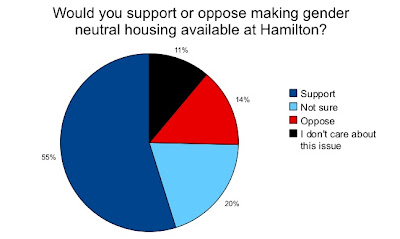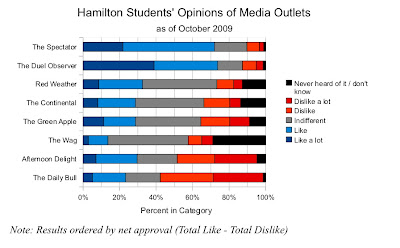From February 25th to March 1st, 2010, the student survey group HamPoll posed a number of questions about gender neutral housing at Hamilton College to students who responded to a survey about Departments and Majors. The results suggest a majority of the student body favors gender neutral housing, which the survey specified as “a housing arrangement in which students of different genders would be allowed to share a room.”
Familiarity with Gender Neutral Housing
A majority of respondents expressed familiarity with gender neutral housing, as can be seen in the following chart.
Support for Gender Neutral Housing
277 students supported making gender neutral housing available at Hamilton, a slim majority of the sample (55%, shown in the following chart). However, only 14% (59 students) were opposed, with the remaining 31% unsure or expressing disinterest.
To further analyze support for gender neutral housing, HamPoll constructed a statistical model that examined how support for gender neutral housing varied as a function of demographic factors. The model revealed that gay, lesbian, and bisexual students were 35% more likely than straight students to support gender neutral housing, while liberal students were 14% more likely to support the idea than moderates or conservatives. Support for gender neutral housing also increased with self-identified familiarity with the issue, with students who were “very familiar” with gender neutral housing being 41% more likely and those “somewhat familiar” 24% more likely to support the issue than those who were less familiar. These results control for sex, class year, race, Greek society membership, financial aid status, varsity sport membership, grades (A student versus non-A student), place of residence (from New York State or not) and attending public or private high school; students from all these groups showed no significant differences in responses.
Types of Gender Neutral Housing Preferred
HamPoll sought to more closely examine the type of gender neutral housing policy that students favored by asking students to pick which of the following options they preferred more: “Allowing students of different genders to share a room anywhere on campus” or “Allowing students of different genders to share a room in specific dorms, similar to current substance-free housing policies.” Overall, 35% of respondents favored the first (all-campus) option; 41% favored limiting gender neutral housing to specific dorms; 15% were not sure; and 9% did not care about the issue.
Notably, among the subset of students who supported a gender neutral housing policy (227 students, or 55% of the sample), 55% (125 students) supported making gender neutral housing available across campus, while 38% (86 students) supported gender neutral housing in certain dorms. While this represented a stronger preference for the entire-campus option among gender neutral housing supporters than among non-supporters, these results suggest some divisions regarding how supporters thought a gender neutral housing policy should best be implemented.
When controlling for demographic variables and familiarity with the issue, men were 12% more likely than women to support an all-campus policy, while juniors were 14% less likely than other class years to support a broad-based implementation. Other demographic variables did not lead to significant differences in preferences for one policy or the other.
Characteristics of the Survey Sample
The survey received 414 valid responses, representing about one-quarter of the student body. The survey sample was self-selected, so results may differ from the overall population; notably, the sample contained a higher proportion of women and white students and fewer varsity athletes and Mid-Atlantic residents than the Hamilton student body in general. However, this pattern of results is largely consistent with previous HamPoll surveys, implying that interest in particular topics on this survey did not strongly skew responses towards one subgroup.
| Demographic Group | Percentage of Students in Survey Sample | Percentage of Students at Hamilton* |
| Female students | 64 | 52 |
| Male students | 35 | 48 |
| Students of color | 14.7 | 16.5 |
| White students | 81.1 | 70.4 |
| Financial aid recipients | 50 | 50 |
| Students without aid | 45 | 50 |
| Varsity athletes | 18 | About 35-40 |
| Mid-Atlantic residents | 42 | 48 |
| New England residents | 28 | 29 |
| International students | 4.8 | 6.2 |
| *Demographics drawn from Hamilton Admissions website (data for 2008-9). Note: percentages may not add to 100% due to exclusion of “Prefer not to answer” and “Other” responses. | ||
Conclusions
A majority of Hamilton students favored gender neutral housing in HamPoll's survey, with students who were more familiar with the issue expressing more support. However, students were divided on whether to implement such a policy across campus or in specific residence halls.
Questions about methodology or data may be directed to Kye Lippold or David Foster, HamPoll Co-Chairs, at hampoll@hamilton.edu.














